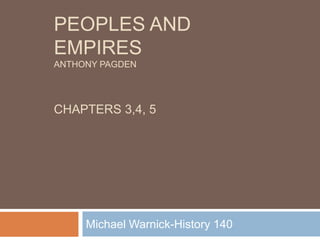
What is history
- 1. Peoples and EmpiresAnthony pagdenChapters 3,4, 5 Michael Warnick-History 140
- 2. Universal Empire European society, despite its continuing indebtedness to Greek science and Greek philosophy, thus became predominantly a Latin one on which the customs and languages of the Germanic invaders left deep and enduring marks. In 800, Pope Leo III, in the name of the people and the city of Rome, conferred upon Charles I, king of the Lombards and the Franks, subsequently known as Charlemagne(742-814), the title of emperor. Charles had inherited his empire from Aeneas and Augustus and Constantine the Great via Charlemagne. Empire was not a single imperium, but a vast sprawling cosmopolitan conglomerate, ruled over by an emperor who had no established capital. Charles’s claims to universalism and his cosmopolitanism were matched only by those of the rulers of the other great empires of what had once been the ancient Hellenic and Roman worlds.
- 3. Conquering The Ocean Scipio’s Dream: Cicero had created a vision of the real world, or at least of the world as Cicero thought it might be. Early 15th century, however, this vision of the world began to change. In 1434 a small fleet of lateen-rigged vessels, known as caravels, barely more than fishing boats, slipped out of the Tagus estuary bound for the unknown waters of West Africa. Early Portuguese voyages to Africa were sponsored by Prince Henry, called by later generations of admiring English sailors “Henry the Navigator.” Later voyages were aimed at securing a direct route to the silks, spicies, precious woods, and other luxury commodities of the east, and, with more enduring and far more sinister consequences, to the trade in African slaves. The “discovery” of America meant, however, more than access to huge deposits of precious metals.
- 4. Spreading The Word Empire of Charles V was not only Roman, it was also Holy. Charles was conscious of his place as the successor to Augustus and Constantine. New Christian world order, whose could not now be separated from those of the Roman Empire, would, as Tertullian had also said, endure as long as “this earthly world.” Christianity accompanied the expanding European empires almost until their final demise in the middle of the Twentieth century. Missionaries lived in an uneasy alliance with the soldiers, adventures, merchants, royal officials, and lawyers who made up the advanced forces of most colonizing voyages. 1544, Sepulveda had written a dialogue in Latin justifying the “wars” waged against the Indians by the Spaniards. Las Casas became symbol of the fight against the injustices of colonialism.